Determination of Odour Interactions in Gaseous Mixtures Using Electronic Nose Methods with Artificial Neural Networks
Abstract
:1. Introduction
2. Materials and Methods
2.1. Types of Gas Odorous Mixtures and Their Preparation
2.2. Measurements of Odour Intensity and Hedonic Tone
2.3. Description of Experimental Setup for Electronic Nose Investigations
- zero air generator
- mass flow controller
- three-way valve
- sample mounting system
- prototype of e-nose equipped with a matrix of eight sensors: five MOS-type sensors, two electrochemical sensors by Figaro Co. and one PID-type sensor (Table 2)
- analogue-to-digital converter
- PC-class computer
2.4. Methodology of Measurement Using Electronic Nose
- volumetric flow rate of air, determined using the mass flow controller: 0.3 L/min;
- time of carrier gas flow through the sample: 50 s; and
- signal recording: 30 s.
2.5. Data Analysis and Artificial Neural Network Structure
2.5.1. Architecture
2.5.2. Training
3. Results and Discussion
3.1. Selection of Optimum Artificial Neural Network Structures
3.2. Validation of Selected Artificial Neural Network Structures on Test Samples
3.3. Determination of Odour Interactions Using Selected Artificial Neural Network Structures
3.4. Influence of Particular Sensors on the Information Acquired from Investigated Odorous Mixtures
4. Conclusions
Acknowledgments
Author Contributions
Conflicts of Interest
References
- Hill, D.T.; Barth, C.L. Quantitative prediction of odor intensity. Trans. ASAE 1976, 19, 939–944. [Google Scholar] [CrossRef]
- Pearce, T.C.; Gardner, J.W. Predicting organoleptic scores of sub-ppm flavour notes Part 2. Computational analysis and results. Analyst 1998, 123, 2057–2066. [Google Scholar] [CrossRef]
- Pearce, T.C.; Gardner, J.W. Predicting organoleptic scores of sub-ppm flavour notes Part 1. Theoretical and experimental details. Analyst 1998, 123, 2047–2055. [Google Scholar] [CrossRef]
- Yan, L.; Liu, J.; Fang, D. Use of a modified vector model for odor intensity prediction of odorant mixtures. Sensors 2015, 15, 5697–5709. [Google Scholar] [CrossRef] [PubMed]
- Yan, L.; Liu, J.; Jiang, S.; Wu, Ch.; Gao, K. The regular interaction pattern among odorants of the same type and its application in odor intensity assessment. Sensors 2017, 17, 1624. [Google Scholar] [CrossRef] [PubMed]
- Laffort, P. Models for describing intensity interactions in odor mixtures: A reappraisal. In Perception of Complex Smells and Tastes; Laing, D.G., Cain, W.S., McBride, R.L., Ache, B.W., Eds.; Academic Press: New York, NY, USA, 1989; pp. 205–223. ISBN 012042990X. [Google Scholar]
- Laffort, P. The application of synergy and inhibition phenomena to odor reduction. In Characterization and Control of Odours and VOC in the Process Industries; Vigneron, S., Hermia, J., Chaouki, J., Eds.; Elsevier: Amsterdam, The Netherlands, 1994; pp. 105–117. ISBN 9780080875200. [Google Scholar]
- Laffort, P.; Dravnieks, A. Several models of suprathreshold quantitative olfactory interaction in humans applied to binary, ternary and quaterny mixtures. Chem. Senses 1982, 7, 153–174. [Google Scholar] [CrossRef]
- Berglund, B.; Berglund, U.; Lindvall, T.; Svensson, L.T. A quantitative principle of perceived intensity summation in odor mixtures. J. Exp. Psychol. 1973, 100, 29–38. [Google Scholar] [CrossRef]
- Rock, F.; Barsan, N.; Weimar, U. Electronic nose: Current status and future trends. Chem. Rev. 2008, 108, 705–725. [Google Scholar] [CrossRef] [PubMed]
- Wilson, A.D.; Baietto, M. Applications and advances in electronic-nose technologies. Sensors 2009, 9, 5099–5148. [Google Scholar] [CrossRef] [PubMed]
- Munoz, R.; Sivret, E.C.; Parcsi, G.; Lebrero, R.; Wang, X.; Suffet, I.H.; Stuetz, R.M. Monitoring techniques for odour abatement assessment. Water Res. 2010, 44, 5129–5149. [Google Scholar] [CrossRef] [PubMed]
- Szulczyński, B.; Gębicki, J. Currently commercially available chemical sensors employed for detection of volatile organic compounds in outdoor and indoor air. Environments 2017, 4, 21. [Google Scholar] [CrossRef]
- Littarru, P. Environmental odours assessment from waste treatment plants: Dynamic olfactometry in combination with sensorial analysers “electronic noses”. Waste Manag. 2007, 27, 302–309. [Google Scholar] [CrossRef] [PubMed]
- Goschnick, J.; Koronczi, I.; Frietsch, M.; Kiselev, I. Water pollution recognition with the electronic nose KAMINA. Sens. Actuators B Chem. 2005, 106, 182–186. [Google Scholar] [CrossRef]
- Kim, H.; Konnanath, B.; Sattigeri, P.; Wang, J.; Mulchandani, A.; Myung, N.; Deshusses, M.A.; Spanias, A.; Bakkaloglu, B. Electronic-nose for detecting environmental pollutants: Signal processing and analog front-end design. Analog Integr. Circuits Signal Process. 2012, 70, 15–32. [Google Scholar] [CrossRef]
- Wilson, A.D. Review of electronic-nose technologies and algorithms to detect hazardous chemicals in the environment. Procedia Technol. 2012, 1, 453–463. [Google Scholar] [CrossRef]
- Gębicki, J.; Szulczyński, B.; Kamiński, M. Determination of authenticity of brand perfume using electronic nose prototypes. Meas. Sci. Technol. 2015, 26, 125103. [Google Scholar] [CrossRef]
- Tian, X.; Wang, J.; Cui, S. Analysis of pork adulteration in minced mutton using electronic nose of metal oxide sensors. J. Food Eng. 2013, 119, 744–749. [Google Scholar] [CrossRef]
- Hong, X.; Wang, J. Detection of adulteration in cherry tomato juices based on electronic nose and tongue: Comparison of different data fusion approaches. J. Food Eng. 2014, 126, 89–97. [Google Scholar] [CrossRef]
- Zhang, H.; Wang, J.; Ye, S. Predictions of acidity, soluble solids and firmness of pear using electronic nose technique. J. Food Eng. 2008, 86, 370–378. [Google Scholar] [CrossRef]
- Serneels, S.; Moens, M.; Van Espen, P.J.; Blockhuys, F. Identification of micro-organisms by dint of the electronic nose and trilinear partial least squares regression. Anal. Chim. Acta 2004, 516, 1–5. [Google Scholar] [CrossRef]
- Nicolas, J.; Cerisier, C.; Delva, J.; Romain, A.C. Potential of a network of electronic noses to assess the odour annoyance in the environment of a compost facility. Chem. Eng. Trans. 2012, 30, 133–138. [Google Scholar] [CrossRef]
- Sabilla, A.I.; Sarno, R.; Siswantoro, J. Estimating gas concentration using artificial neural network for electronic nose. Procedia Comput. Sci. 2017, 124, 181–188. [Google Scholar] [CrossRef]
- Herrero, J.L.; Lozano, J.; Santos, J.P.; Suarez, J.I. On-line classification of pollutants in water using wireless portable electronic noses. Chemosphere 2016, 152, 107–116. [Google Scholar] [CrossRef] [PubMed]
- Deshmukh, S.; Kamde, K.; Jana, A.; Korde, S.; Bandyopadhyay, R.; Sankar, R.; Bhattacharyya, N.; Pandey, R.A. Calibration transfer between electronic nose systems for rapid in situ measurement of pulp and paper industry emissions. Anal. Chim. Acta 2014, 841, 58–67. [Google Scholar] [CrossRef] [PubMed]
- Szczurek, A.; Szecówka, P.M.; Licznerski, B.W. Application of sensor array and neural networks for quantification of organic solvent vapours in air. Sens. Actuators B Chem. 1999, 58, 427–432. [Google Scholar] [CrossRef]
- Badura, M.; Szczurek, A.; Szecówka, P.M. Statistical assessment of quantification methods used in gas sensor system. Sens. Actuators B Chem. 2013, 188, 815–823. [Google Scholar] [CrossRef]
- Majchrzak, T.; Wojnowski, W.; Dymerski, T.; Gębicki, J.; Namieśnik, J. Electronic noses in classification and quality control of edible oils: A review. Food Chem. 2018, 246, 192–201. [Google Scholar] [CrossRef] [PubMed]
- Hudon, G.; Guy, Ch.; Hermia, J. Measurement of odor intensity by an electronic nose. J. Air Waste Manag. Assoc. 2000, 50, 1750–1758. [Google Scholar] [CrossRef] [PubMed]
- Szulczyński, B.; Namieśnik, J.; Gębicki, J. Determination of odour interactions of three-component gas mixtures using an electronic nose. Sensors 2017, 17, 2380. [Google Scholar] [CrossRef] [PubMed]
- Guillot, J.; Milan, B. E-noses: Actual limitations and perspectives for environmental odour analysis. Chem. Eng. Trans. 2016, 54, 223–228. [Google Scholar] [CrossRef]
- Amoore, J.E.; Hautala, E. Odor as an aid to chemical safety: Odor thresholds compared with threshold limit values and volatilities for 214 industrial chemicals in air and water dilution. J. Appl. Toxicol. 1983, 3, 272–290. [Google Scholar] [CrossRef] [PubMed]
- Czerny, M.; Christlbauer, M.; Christlbauer, M.; Fischer, A.; Granvogl, M.; Hammer, M.; Hartl, C.; Hernandez, N.M.; Schieberle, P. Re-investigation on odour thresholds of key food aroma compounds and development of an aroma language based on odour qualities of defined aqueous odorant solutions. Eur. Food Res. Technol. 2008, 228, 265–273. [Google Scholar] [CrossRef]
- Kohavi, R. A study of cross-validation and bootstrap for accuracy estimation and model selection. In Proceedings of the 14th International Joint Conference on Artificial Intelligence, Montreal, QC, Canada, 20–25 August 1995; pp. 1137–1143. [Google Scholar]
- LeCun, Y.; Bottou, L.; Orr, G.B.; Müller, K.R. Efficient BackProp. In Neural Networks: Tricks of the Trade. Lecture Notes in Computer Science; Orr, G.B., Müller, K.R., Eds.; Springer: Berlin, Germany, 1998; Volume 1524, pp. 9–50. ISBN 978-3-540-65311-0. [Google Scholar]
- LeCun, Y.; Bengio, Y.; Hinton, G. Deep learning. Nature 2015, 521, 436–444. [Google Scholar] [CrossRef] [PubMed]
- Barron, A.R. Universal approximation bounds for superpositions of a sigmoidal function. IEEE Trans. Inf. Theory 1993, 39, 930–945. [Google Scholar] [CrossRef]
- Maas, A.L.; Hannun, A.Y.; Ng, A.Y. Rectifier nonlinearities improve neural network acoustic models. In Proceedings of the 30th International Conference on Machine Learning, Atlanta, GA, USA, 16–21 June 2013. [Google Scholar]
- Glorot, X.; Bengio, Y. Understanding the difficulty of training deep feedforward neural networks. In Proceedings of the Thirteenth International Conference on Artificial Intelligence and Statistics, Sardinia, Italy, 13–15 May 2010; pp. 249–256. [Google Scholar]
- Zhang, J.R.; Zhang, J.; Lok, T.M.; Lyu, M.R. A hybrid particle swarm optimization–back-propagation algorithm for feedforward neural network training. Appl. Math. Comput. 2007, 185, 1026–1037. [Google Scholar] [CrossRef]
- Erhan, D.; Bengio, Y.; Courville, A.; Manzagol, P.A.; Vincent, P.; Bengio, S. Why does unsupervised pre-training help deep learning? J. Mach. Learn. Res. 2010, 11, 625–660. [Google Scholar]
- Vincent, P.; Larochelle, H.; Bengio, Y.; Manzagol, P. Extracting and composing robust features with denoising autoencoders. In Proceedings of the 25th International Conference on Machine Learning, Helsinki, Finland, 5–9 July 2008; pp. 1096–1103. [Google Scholar]
- Vincent, P.; Larochelle, H.; Lajoie, I.; Bengio, Y.; Manzagol, P.A. Stacked denoising autoencoders: Learning useful representations in a deep network with a local denoising criterion. J. Mach. Learn. Res. 2010, 11, 3371–3408. [Google Scholar]
- Wu, Ch.; Liu, J.; Yan, L.; Chen, H.; Shao, H.; Meng, T. Assessment of odor activity value coefficient and odor contribution based on binary interaction effects in waste disposal plant. Atmos. Environ. 2015, 103, 231–237. [Google Scholar] [CrossRef]
- Wu, Ch.; Liu, J.; Zhao, P.; Piringer, M.; Schauberger, G. Conversion of the chemical concentration of odorous mixtures into odour concentration and odour intensity: A comparison of methods. Atmos. Environ. 2016, 127, 283–292. [Google Scholar] [CrossRef]
- Yan, L.; Liu, J.; Wang, G.; Wu, Ch. An odor interaction model of binary odorant mixtures by a partial differential equation method. Sensors 2014, 14, 12256–12270. [Google Scholar] [CrossRef] [PubMed]
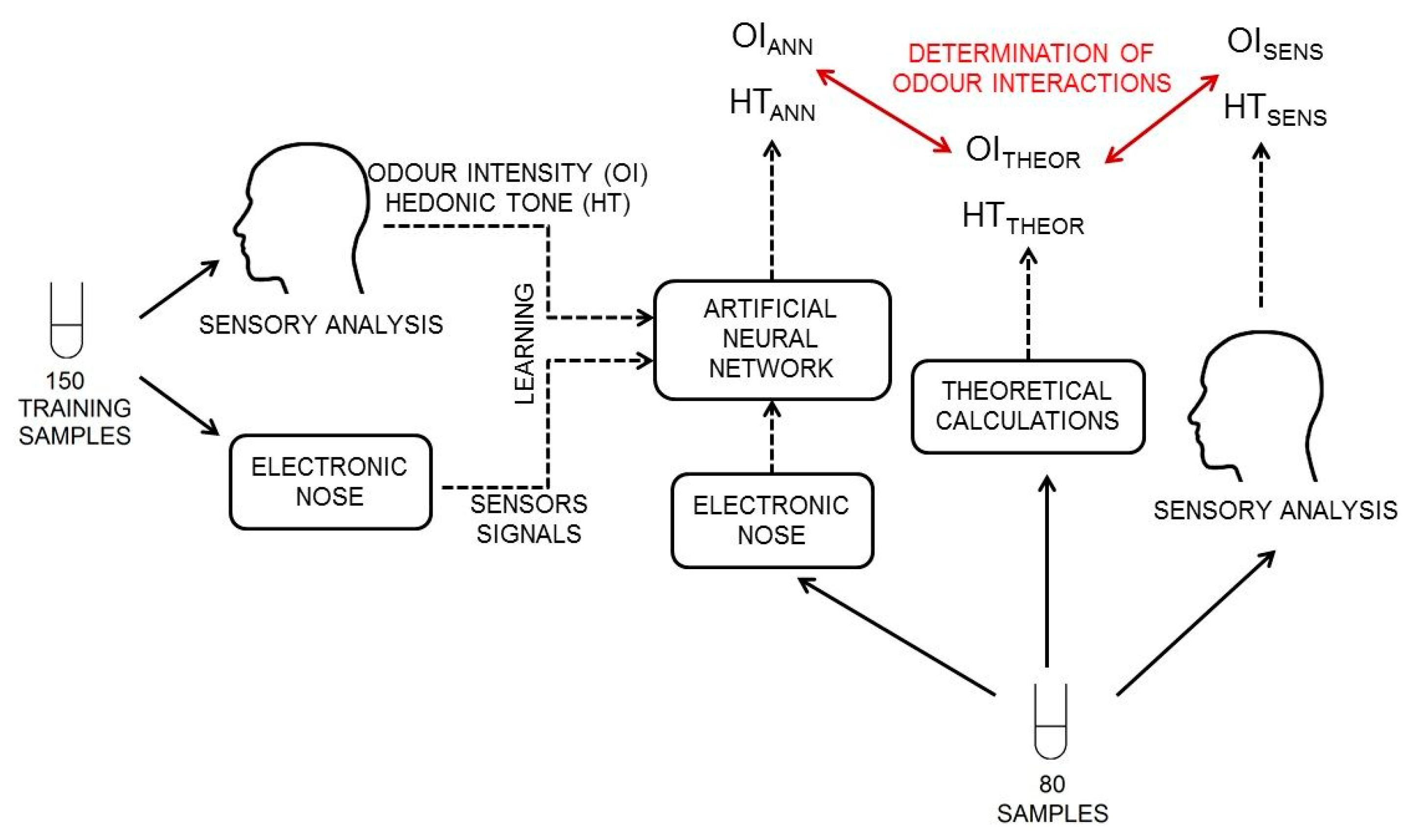
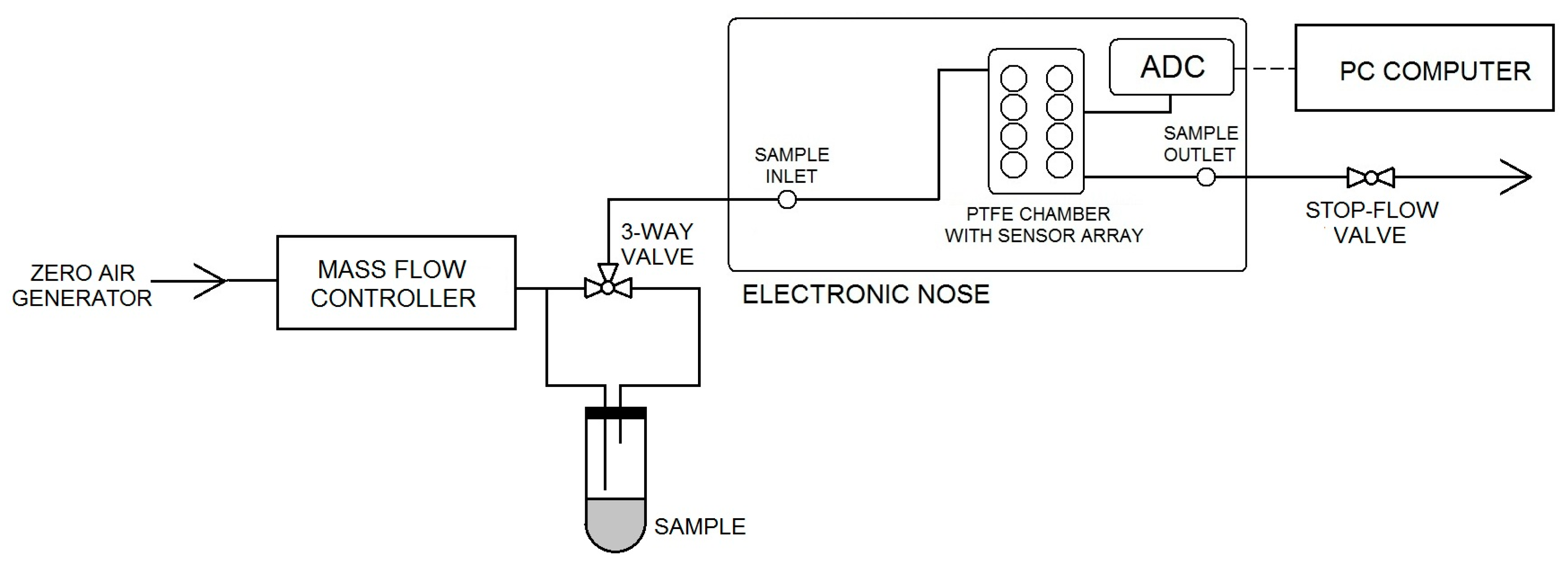
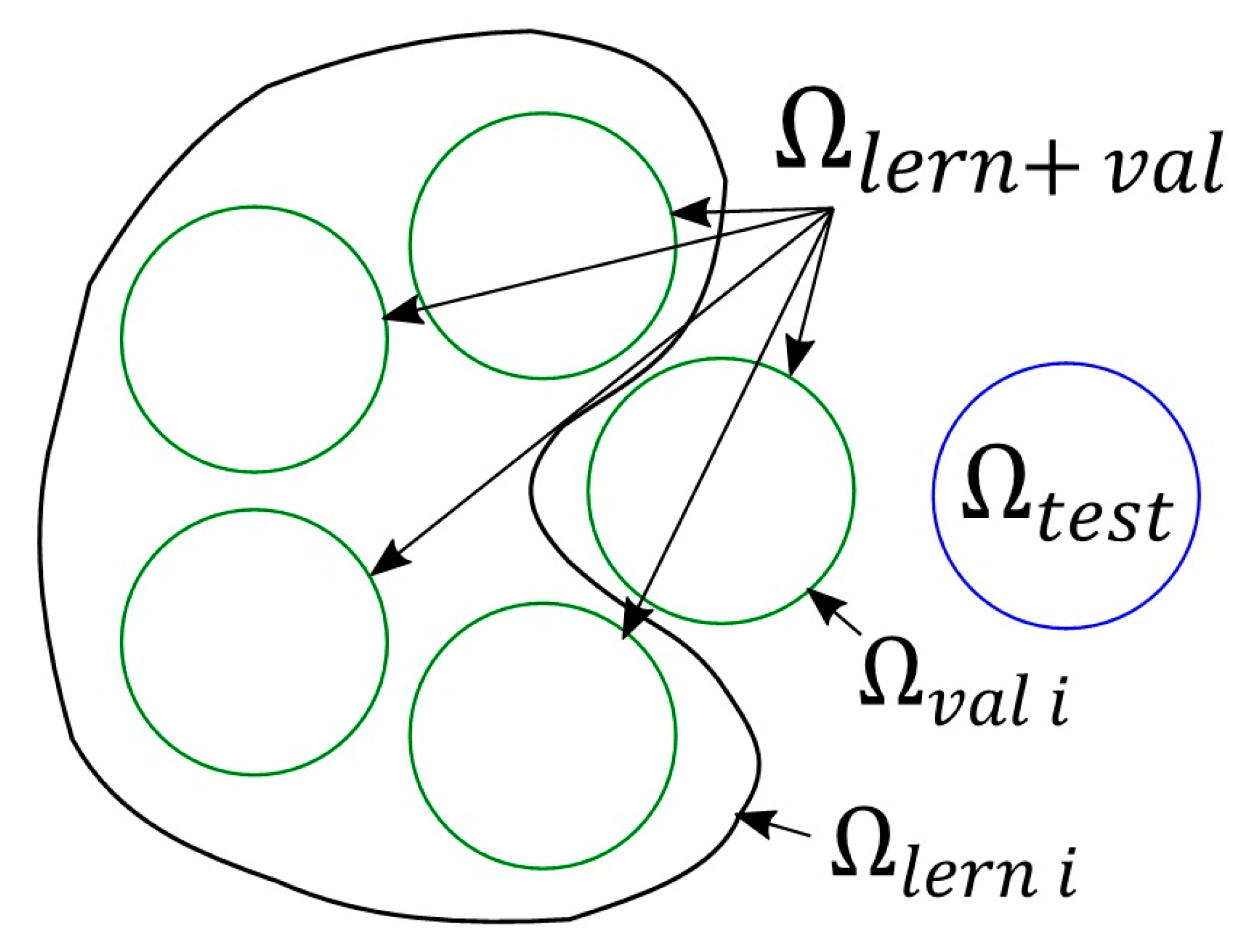
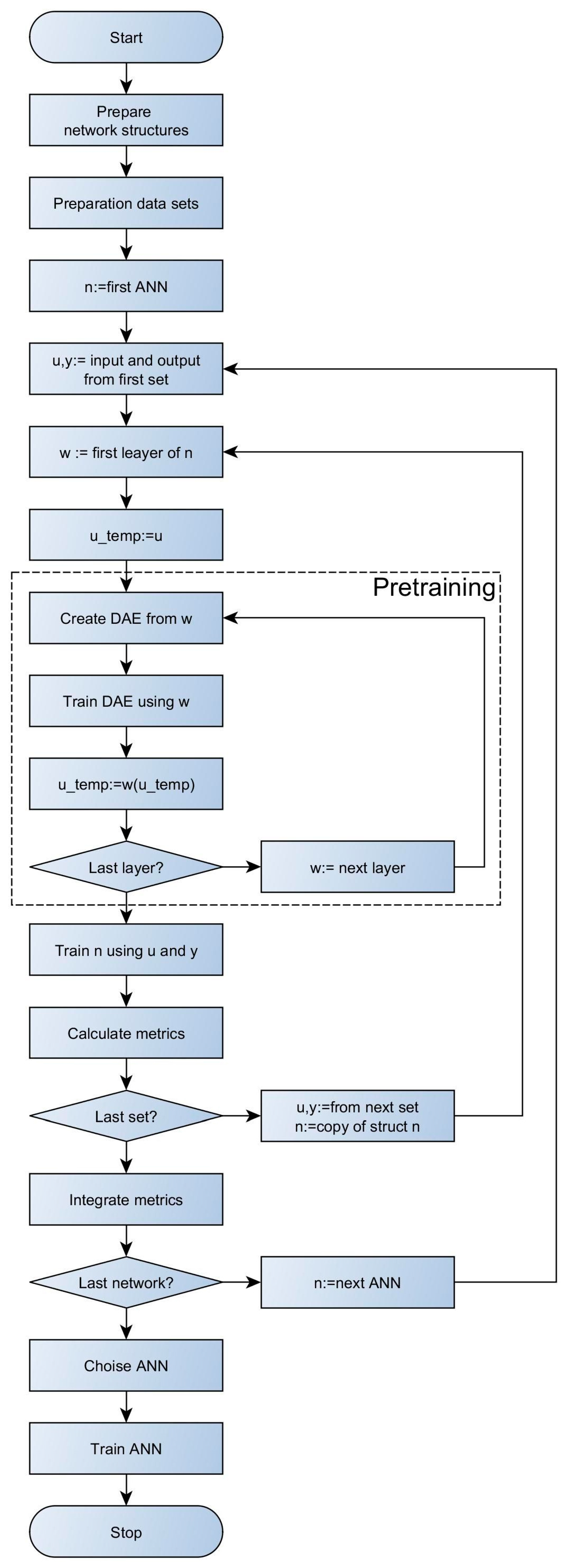
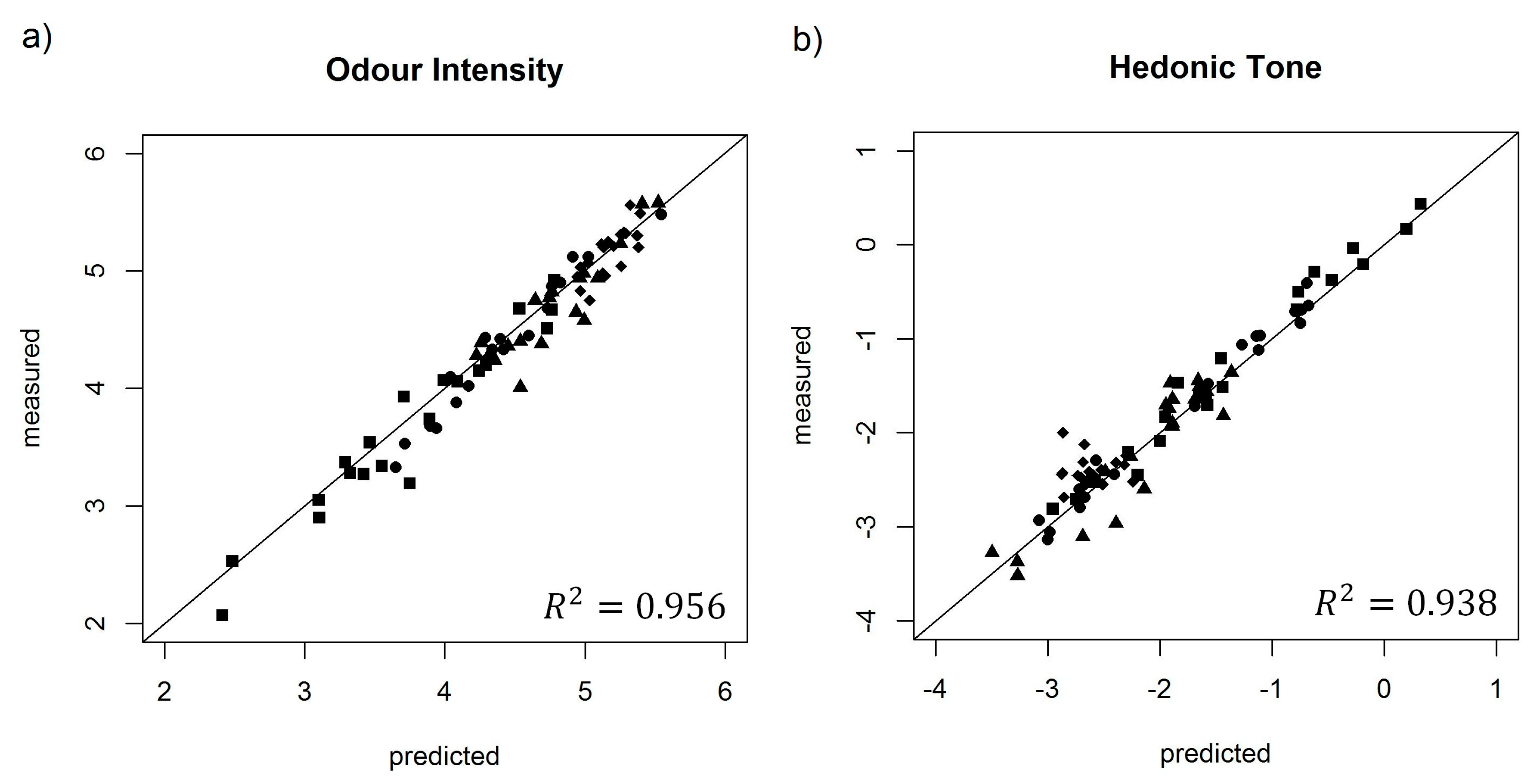
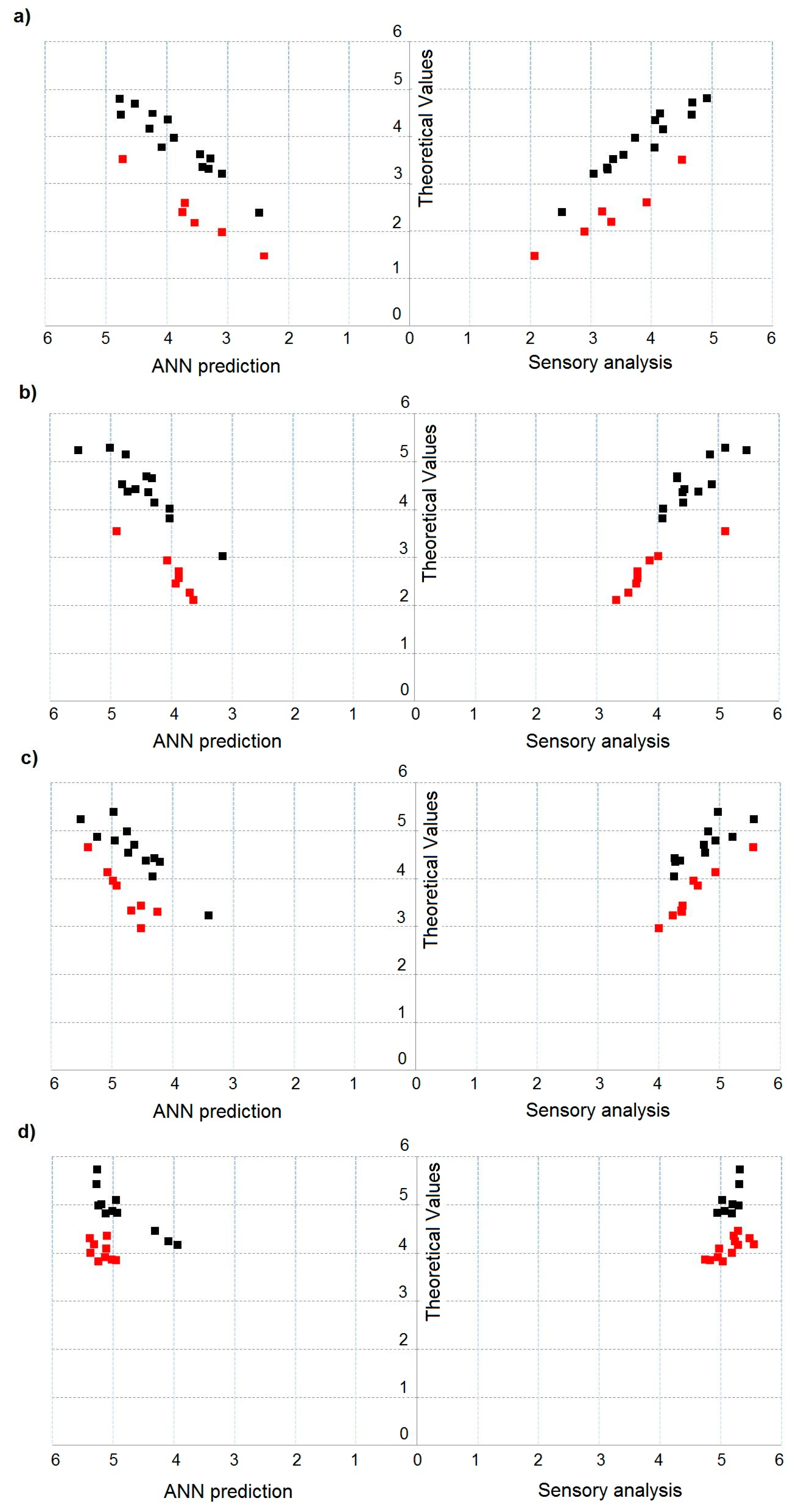
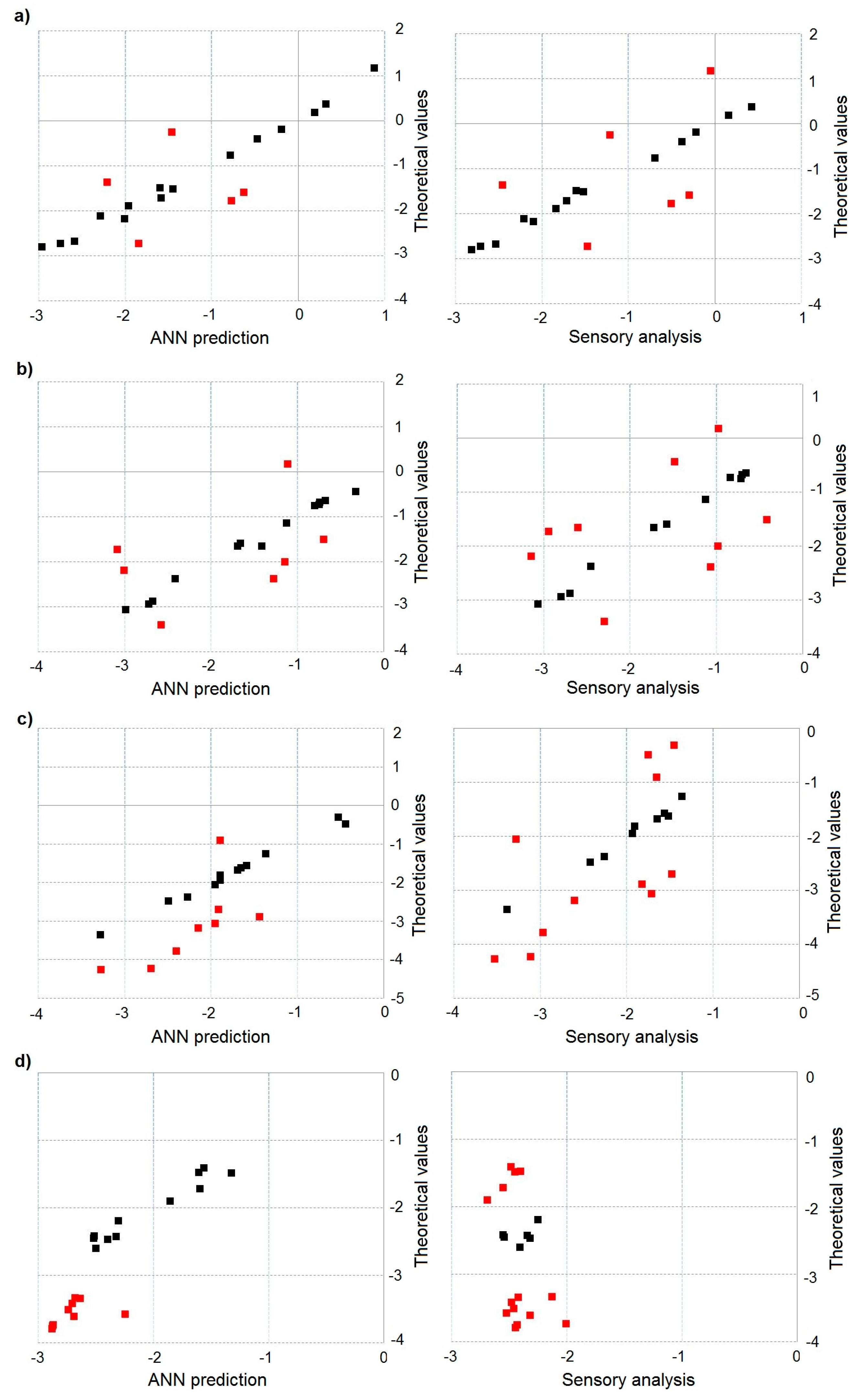

| Substance | Odour Type | Vapour Pressure (hPa) | Olfactory Threshold in Gas Phase (ppm v/v) | Olfactory Threshold in Aqueous Solutions (ppm w/v) |
|---|---|---|---|---|
| toluene | pleasant and characteristic | 29 | 0.33–2.9 | 0.042 |
| acetone | fruity, sweet | 233 | 13–100 | 20 |
| triethylamine | fish, pungent | 72 | 0.000032–0.48 | 0.42 |
| n-butanol | rancid, sweet | 8 | 0.038–1 | 7.1 |
| α-pinene | pine, resinous | 5 | 0.018 | 4.2 |
| Sensor Type | Model/Manufacturer | Target Gases | Typical Detection Range | Sensitivity |
|---|---|---|---|---|
| PID | MiniPID/ION Science | VOCs | 1 ppb–40 ppm isobutylene | 25 mV/ppm |
| EC | FECS44-100/Figaro | Ammonia | 1~100 ppm | 0.1 µA/ppm |
| EC | FECS50-100/Figaro | Hydrogen Sulphide | 1~100 ppm | 0.7 µA/ppm |
| MOS | TGS2600/Figaro | Air contaminants | 1~10 ppm H2 | 0.3~0.6 a |
| MOS | TGS823/Figaro | Organic Solvent Vapours | 50~1000 ppm n-hexane | 0.4 ± 0.1 a |
| MOS | TGS2602/Figaro | Gaseous air contaminants (VOCs and odorous gases) | 1~30 ppm EtOH | 0.15~0.5 a |
| MOS | TGS2603/Figaro | Air contaminants (trimethylamine, methylmercaptan, etc.) | 1~30 ppm EtOH | ~0.5 a |
| MOS | TGS8100/Figaro | Air contaminants (hydrogen, ethanol, etc.) | 1~30 ppm H2 | ~0.6 a |
| Proposed Structures | ANN Schematic |
|---|---|
| 8-10-0-1 8-15-0-1 8-2-0-1 8-3-0-1 8-3-2-1 8-3-3-1 8-5-0-1 8-5-2-1 8-5-3-1 8-5-4-1 8-5-5-1 |  |
| Odour Intensity | Hedonic Tone | ||||
|---|---|---|---|---|---|
| ANN Structure | RMSECV | R2 | ANN Structure | RMSECV | R2 |
| 8-10-0-1 | 0.55 | 0.432 | 8-10-0-1 | 0.73 | 0.822 |
| 8-15-0-1 | 0.54 | 0.437 | 8-15-0-1 | 2.86 | 0.312 |
| 8-2-0-1 | 0.11 | 0.880 | 8-2-0-1 | 0.51 | 0.875 |
| 8-3-0-1 | 0.10 | 0.896 | 8-3-0-1 | 0.58 | 0.858 |
| 8-3-2-1 | 0.11 | 0.886 | 8-3-2-1 | 0.59 | 0.857 |
| 8-3-3-1 | 0.10 | 0.899 | 8-3-3-1 | 0.60 | 0.852 |
| 8-5-0-1 | 0.12 | 0.877 | 8-5-0-1 | 0.67 | 0.834 |
| 8-5-2-1 | 0.15 | 0.837 | 8-5-2-1 | 0.38 | 0.908 |
| 8-5-3-1 | 0.20 | 0.783 | 8-5-3-1 | 0.51 | 0.875 |
| 8-5-4-1 | 0.20 | 0.787 | 8-5-4-1 | 0.68 | 0.833 |
| 8-5-5-1 | 0.27 | 0.710 | 8-5-5-1 | 0.78 | 0.809 |
| Odour Intensity | Hedonic Tone | ||||
|---|---|---|---|---|---|
| ANN Structure | RMSECV | R2 | ANN Structure | RMSECV | R2 |
| 8-10-0-1 | 0.28 | 0.708 | 8-10-0-1 | 0.78 | 0.824 |
| 8-15-0-1 | 0.16 | 0.834 | 8-15-0-1 | 0.86 | 0.792 |
| 8-2-0-1 | 0.13 | 0.866 | 8-2-0-1 | 0.49 | 0.895 |
| 8-3-0-1 | 0.11 | 0.880 | 8-3-0-1 | 0.42 | 0.895 |
| 8-3-2-1 | 0.10 | 0.890 | 8-3-2-1 | 0.28 | 0.932 |
| 8-3-3-1 | 0.11 | 0.884 | 8-3-3-1 | 0.32 | 0.921 |
| 8-5-0-1 | 0.11 | 0.883 | 8-5-0-1 | 0.28 | 0.930 |
| 8-5-2-1 | 0.13 | 0.866 | 8-5-2-1 | 0.30 | 0.927 |
| 8-5-3-1 | 0.10 | 0.888 | 8-5-3-1 | 0.33 | 0.919 |
| 8-5-4-1 | 0.16 | 0.828 | 8-5-4-1 | 0.36 | 0.910 |
| 8-5-5-1 | 0.11 | 0.882 | 8-5-5-1 | 0.32 | 0.921 |
| Amount of Mixture Components | RMSEP | |
|---|---|---|
| Odour Intensity (8-3-3-1 tanh) | Hedonic Tone (8-3-2-1 Leaky ReLUs) | |
| 2 | 0.13 | 0.28 |
| 3 | 0.16 | 0.33 |
| 4 | 0.19 | 0.36 |
| 5 | 0.20 | 0.47 |
| Amount of Mixture Components | Odour Intensity Interactions | Hedonic Tone Interactions | ||
|---|---|---|---|---|
| Sensory Analysis—Theoretical | ANN—Theoretical | Sensory Analysis—Theoretical | ANN—Theoretical | |
| 2 | 6 | 6 (100%) | 6 | 5 (83%) |
| 3 | 8 | 7 (88%) | 9 | 7 (78%) |
| 4 | 9 | 8 (89%) | 11 | 8 (73%) |
| 5 | 12 | 9 (75%) | 14 | 9 (64%) |
© 2018 by the authors. Licensee MDPI, Basel, Switzerland. This article is an open access article distributed under the terms and conditions of the Creative Commons Attribution (CC BY) license (http://creativecommons.org/licenses/by/4.0/).
Share and Cite
Szulczyński, B.; Armiński, K.; Namieśnik, J.; Gębicki, J. Determination of Odour Interactions in Gaseous Mixtures Using Electronic Nose Methods with Artificial Neural Networks. Sensors 2018, 18, 519. https://doi.org/10.3390/s18020519
Szulczyński B, Armiński K, Namieśnik J, Gębicki J. Determination of Odour Interactions in Gaseous Mixtures Using Electronic Nose Methods with Artificial Neural Networks. Sensors. 2018; 18(2):519. https://doi.org/10.3390/s18020519
Chicago/Turabian StyleSzulczyński, Bartosz, Krzysztof Armiński, Jacek Namieśnik, and Jacek Gębicki. 2018. "Determination of Odour Interactions in Gaseous Mixtures Using Electronic Nose Methods with Artificial Neural Networks" Sensors 18, no. 2: 519. https://doi.org/10.3390/s18020519






